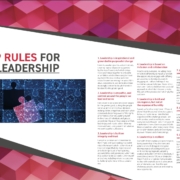Managing Diverse Collaboration in a Virtual Environment When Leading Innovation
Managing Diverse Collaboration in a Virtual Environment When Leading Innovation
Adam Kingl
A plethora of collaboration dysfunctions can easily derail innovation conversations. I began conducting a number of experiments ten years ago to explore virtual and face to face dynamics, and which may be optimal, when holding conversations requiring creative inputs from a team. These experiments demonstrated that team leaders should consider continuing to hold at least some of their innovation discussions on virtual platforms, even if the pandemic would technically allow the team to meet in person. There are two important reasons for this recommendation.
First, charisma or extraversion, a traditional leadership trait, is often disintermediated in a virtual environment. The extrovert jumps in with their contribution first and often, while the introvert is still processing options and responses. But on an asynchronous, virtual discussion platform like a discussion board, team members cannot rely on force of personality to push solutions, but on the clarity and quality of their ideas. Introverts, and those who are less confident working in a second language, may actually thrive more in a virtual team.
Second, merit has more power than familiarity or hierarchy in virtual teams. We have all experienced how factors such as cultural norms, gender, career levels and reporting lines contribute to only a few voices, sometimes only one voice, dominating in a room. Most of our organisations’ architectures are predicated on a pyramidal hierarchy, which for centuries has suggested a tacit dogma of the manager’s infallibility. This canon has ruined many millions of meetings, where idea creation gives way to waiting for the leader to contribute, and then the rest of the team either agreeing or remaining silent.
In a virtual, asynchronous environment, team members scan reflect before answering, the less confident can reply thoughtfully and bravely. Adding anonymity to contributions reduces the senior voices from owning the lion’s share of the conversation. The best ideas rise to the top instead of those which happen to be from the most senior. Therefore, if an important objective of any leader is to bring out the best in everyone, then he or she should consider utilising a virtual forum for at least some discussions and particularly if managing a very diverse team.
Two important points to remember when considering virtual teamwork:
First, technology does not solve every problem. Virtual teamwork can fail if leaders do not attend to the fundamental problems of coordinating, engaging, and motivating individuals, particularly across time zones. It’s easy for team members to disengage when they’re not face-to-face, so the leader must convey a high degree of enthusiasm and clarity and agree on who is accountable for what from the start.
Second, it is dangerous to assume everyone has the same understanding of how the virtual team with work together. For example, will everyone be in one virtual ‘place’ at the same time, or will they contribute on their own time? To lead a virtual team, the leader must focus more on team maintenance (‘How are we going to work together?’) before task maintenance (‘’What is the creative solution to the problem or opportunity?’).
When to Leverage the Expert or the Crowd
I am mindful that the expert in the team must still be given his or her due in creative conversations, particularly when understanding technical issues or opportunities would be key. I would argue that the smaller the team, the more this lesson is true. On the other hand, a possibly negative team dynamic that could occur is that the expert is used to being right and may win a debate just through the power of his or her own confidence and of having more data to hand. With larger teams, I recommend a balance between considering the expert view and leveraging the collective wisdom inherent in diversity and large groups. The following table is a short-hand guide suggesting when to utilise the expert and when the ‘crowd’ in a given team.
| Size of Team | Use of Experts | Use of Diverse Group |
| Small (seven or fewer people) | Experts are more likely to provide some of the best answers | May not have powerful diversity in a small number so the ‘crowd’ is less likely to provide the best answers |
| Medium (eight to twenty people) | Solicit the experts’ opinions separately from the group to avoid rushing to an answer | Discuss with the team before bringing the experts back into the dialogue |
| Large (twenty-one plus people) | Solicit the experts’ opinions; test the team’s collective view of those opinions | Survey the team’s views and look for trends and averages |
| Organisation-wide | Gather a group of experts with diverse views to test the emerging views of the wider organisation for rigour and/or to ask follow-up questions | Consider using an internal company platform or social media to collect large samples, votes and discussion boards to test ideas |
Another solution may be to consider the views of the crowd and the expert separately, so that one view does not influence or anchor the other, and then share for discussion. A final recommendation is to find ways in which the emerging collective view is not a victim of groupthink.
A diverse group’s mosaic of different views can balance the important but perhaps narrower view of the expert. The challenge for the manager of such a team or organisation is to find incentives and create cultural norms that make the soliciting of views a regular occurrence, while identifying patterns, averages and trends in those views, and then encouraging rigorous debate. Instead of following the cliché of ‘agreeing to disagree,’ perhaps embracing multiple and diverse points of view could lead to the stronger though less intuitive paradigm of ‘disagreement to convergence.’
Adam Kingl (www.adamkingl.com) is an Associate of the Moller Institute, Churchill College, University of Cambridge. He is the author of the book Next Generation Leadership and an educator and adviser. Formerly, Adam was the Regional Managing Director, Europe, of Duke Corporate Education and the Executive Director of Thought Leadership at London Business School.
https://indd.adobe.com/view/bb16cf03-6c8a-4d66-8ae3-90c406118980
Inspire Magazine, The Møller Institute at Churchill College, University of Cambridge, Issue 4, Leadership Mindsets, pp.32-33












